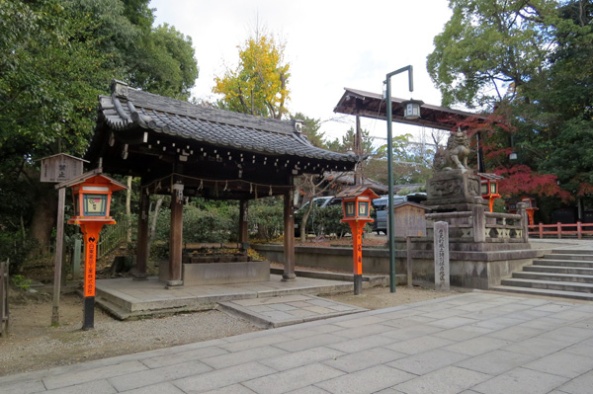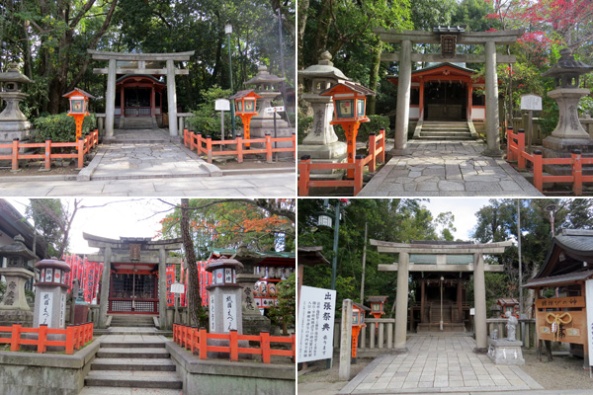A huge reason why my visit to Yasaka Shrine was more memorable and meaningful was the fact that I was wearing a kimono. Sure, there were awkward moments (OK, who am I kidding, there were a LOT of awkward moments) but then, a few minutes into it, I just thought, “wth, I’m here, this is happening, I might as well enjoy it!” And I am glad I did.
Yasaka Shrine, or the Yasakajinja, is also known as the Gion Shrine, primarily because it is a popular landmark in the Gion district. In fact, if you’re feeling disoriented while walking around the streets of Gion, my best suggestion is to look for Yasaka Shrine and use it as your point of reference.
This Shinto shrine was build in 656 AD and was dedicated to Susa-no-o, the god of prosperity and good health. It is also the site of the world-famous annual Gion Matsuri (Gion Festival), which is held every July, and is touted to be the most famous festival in the country. That, I think, is going to be a tough call to make, especially when there seems to be A LOT of matsuris going around in this country.
 The main entrance to the shrine is facing the Fourth Avenue, or Shijo-dori. There you will see the imposing Ro-mon, with its “bright red posts and white walls”. Two Shinto guardians flank the entrance, one on both sides, and they are supposedly to ward off evil spirits from entering the area.
The main entrance to the shrine is facing the Fourth Avenue, or Shijo-dori. There you will see the imposing Ro-mon, with its “bright red posts and white walls”. Two Shinto guardians flank the entrance, one on both sides, and they are supposedly to ward off evil spirits from entering the area.

 The Shrine is open all year round, all day (24 hours) and there are no fees to be paid in order to enter it. We were actually hesitating at first at the foot of the steps, looking for a ticket booth or something, but we just noted how everyone’s going straight right in, so we figured it’s free. It turns out that this place is always open and anyone can come in at any time for their prayers.
The Shrine is open all year round, all day (24 hours) and there are no fees to be paid in order to enter it. We were actually hesitating at first at the foot of the steps, looking for a ticket booth or something, but we just noted how everyone’s going straight right in, so we figured it’s free. It turns out that this place is always open and anyone can come in at any time for their prayers.
I’ve gotten pretty used to seeing an area for the washing of the hands and mouth. And also what I call the mini Shinto shrines. And on the right side, if you can spot it, is the statue of a koma-inu, or a lion-dog. Again, this is a protector, and there are actually a number of these koma-inus lining the stairs that lead up to the central area of the Shrine.
 Below are some of the mini shrines we passed by while walking towards the central area.
Below are some of the mini shrines we passed by while walking towards the central area.

 Finally, we arrived at the main or central area of the Shrine. Of course, there’s the spot where you can get the tablets and prayer sheets to write on. There were quite a number of young people, in their school uniforms, hanging their petitions and prayers.
Finally, we arrived at the main or central area of the Shrine. Of course, there’s the spot where you can get the tablets and prayer sheets to write on. There were quite a number of young people, in their school uniforms, hanging their petitions and prayers.

 That building on the left is actually a combination of two structures. First is as the offertory building, or the haiden. Second is as the main hall (the Spirit Hall) of the Shrine, the honden. Here, offerings are made, and prayers are delivered, but not before they first tug on the thick ropes and rattle the pan-shaped bells. Supposedly, the sound will wake up the gods so they can hear your prayers.
That building on the left is actually a combination of two structures. First is as the offertory building, or the haiden. Second is as the main hall (the Spirit Hall) of the Shrine, the honden. Here, offerings are made, and prayers are delivered, but not before they first tug on the thick ropes and rattle the pan-shaped bells. Supposedly, the sound will wake up the gods so they can hear your prayers.


 Right in front of the honden is the ceremonial stage of the Shrine. It is distinct for having a loooooot of lanterns. Religious ceremonies are often held on this stage, and it’s also where dances are performed. At night, all the lanterns are lit to illuminate the stage. I can almost imagine how it’d look like.
Right in front of the honden is the ceremonial stage of the Shrine. It is distinct for having a loooooot of lanterns. Religious ceremonies are often held on this stage, and it’s also where dances are performed. At night, all the lanterns are lit to illuminate the stage. I can almost imagine how it’d look like.




 I thought the place was quite small as compared to, say, Sumiyoshi Taisha or Shitennoji Temple. But I found it easier to navigate, haha! It is certainly a welcome idea, considering how it’d probably be difficult to go through winding alleyways while wearing kimono. Maaaan, all respect to the Japanese ladies who do so on a regular basis!
I thought the place was quite small as compared to, say, Sumiyoshi Taisha or Shitennoji Temple. But I found it easier to navigate, haha! It is certainly a welcome idea, considering how it’d probably be difficult to go through winding alleyways while wearing kimono. Maaaan, all respect to the Japanese ladies who do so on a regular basis!
We stayed at an area on the outskirts of the Gion area, so all we had to do was walk through maze-like streets and alleyways (THANK YOU GOOGLE MAPS!) until we found helpful signs and arrows. Haha! Of course, before hitting Yasaka Shrine, we first went to yume kyoto to get kitted out in kimonos, and it helped that the place was right beside the shrine.
The Shrine is connected to a small park, Maruyama Kouen, where we headed to right after this. But that is for another post, just because it deserves its own post. 🙂
For now, here’s a view of the street once you stand on the main entrance of Yasaka Shrine.




